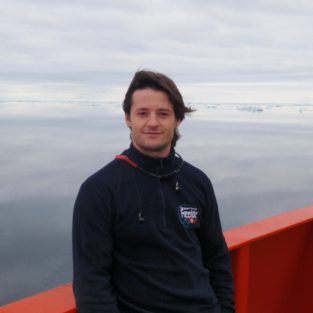Weddell Sea and Dronning Maud Land (WSDML) and Amundsen and Bellingshausen Sector (ABS) Regional Working Groups Welcome New Co-Chairs

The Weddell Sea and Dronning Maud Land (WSDML) RWG are delighted to welcome Dr Stefanie Arndt as co-chair. Stefanie joins Markus Janout in co-chairing WSDML. The working group would like to thank Dr Sebastien Moreau who was co-chair from 2018 to mid-2021 when he was selected as the new SOOS Vice Chair.
Dr Stefanie Arndt is a sea ice physicist at the Alfred Wegener Institute (AWI), Helmholtz Centre for Polar and Marine Research in Bremerhaven. She also lectures in the sea ice physics master’s programme at Universität Hamburg. She was born in Berlin in 1988, and studied meteorology in Berlin and Hamburg, as well as Arctic geophysics in a master’s block course on Spitsbergen. In 2017 she completed her doctorate at the University of Bremen and the AWI on seasonal Arctic and Antarctic surface properties and their influence on the under-ice light field. During her doctorate she spent three months at the Institute for Marine and Antarctic Studies (IMAS), University of Tasmania, in Hobart, Tasmania. As a research associate in the AWI’s sea ice physics section, she coordinates, among other things, the sea ice programme at the German Antarctic research station Neumayer III, as well as the section’s field work in the ice-covered Southern Ocean. To date, Arndt has participated in nine ship-based and two land-based expeditions to the Arctic and Antarctic, including the MOSAiC expedition, in which she led the international sea ice team on board during the third leg of the expedition. She is also active in various national and international networks, including as German representative at the Association of Polar Early Career Scientists (APECS), the Year of Polar Prediction (YOPP) and the international working groups Antarctic Fast Ice Network, and Antarctic Sea Ice Processes and Climate (ASPeCt). In the latter she is also a member of the executive committee. Furthermore, she invests significant time and energy in scientific communication.

The Amundsen and Bellingshausen Sector (ABS) RWG also welcomes a new co-chair, Dr Pierre Dutrieux. Pierre joins Prof. Patricia Yager co-chairing ABS. The working group would like to thank Dr Bastien Queste, the inaugral co-chair of ABS, co-chairing from 2019 till mid-2021.







